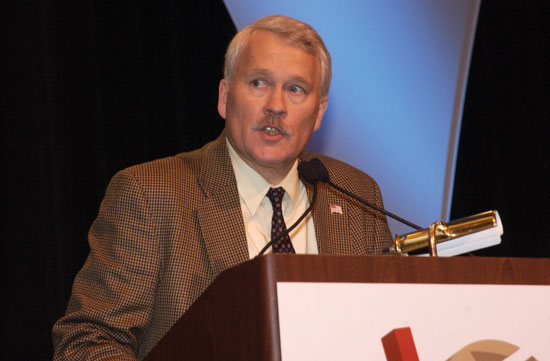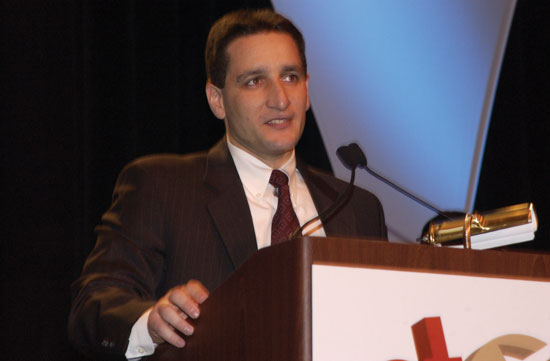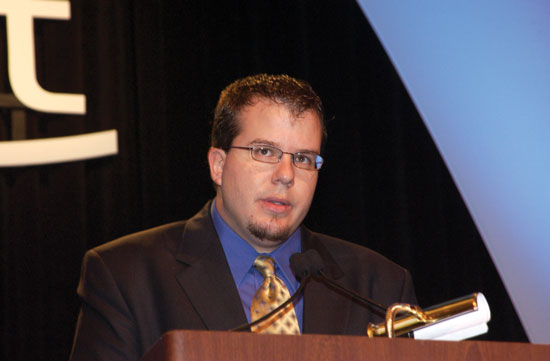ET 2004 and the All-Digital Swagger:
Engineers who met in Dallas to plot the all-digital future came with a not-if-but-when swagger and an eye on the bottom line. The SCTE deliberately weighted this year’s Conference on Emerging Technologies toward the future-the emerging rather than the emerged. Always hard to distinguish, those two categories are more blurred in the case of digital technology, which is mature enough to inspire confidence in its ability to generate real returns on investment. The announcement from Charter Communications on the final day of ET 2004, for instance, that it had activated all-digital video service in its Long Beach, Calif., system was evidence enough that the the industry has already begun "delivering on the promise of the all-digital network"-the theme of this year’s conference. Yet the industry is far from the goal that Tom Staniec, vice president of network operations and engineering at Time Warner Cable, outlined in his pre-conference tutorial. Namely: a network that can provide "anything on demand, from anywhere to anywhere, from anyone to anyone, at any time, (and) in any format." Getting there will require synchronized collaboration with technology providers, Staniec said. Keep your vendors in the loop, he urged operators in attendance. Give them your best guess of what you will need, many months ahead of time-and by whatever means. One vendor, for instance, converted some notes that Staniec had sketched on a cocktail napkin into a prototype, he said. Never mind that Staniec’s ideas on how to use this "lambda on a pole" had shifted by the time it showed up. His message was that filling the holes that inhibit cable from realizing the truly all-digital network will take a lot of teamwork. All-digital Ferrari Discussion of the all-digital network leads sooner or later to talk of capacity. Those attending Staniec’s colorful talk heard it sooner. "What I’m really interested in is raw capacity," he said. "It’s kind of like having a Ferrari in a 25 mph neighborhood. The day will come when you can use it." In the same spirit, John Eng, CableLabs director of DOCSIS platforms, kicked off the panel on DOCSIS and digital migration urging attendees to push ahead: "Now is the time to exploit HFC." Eng spelled out several all-digital spectrum scenarios, noting that more efficient video codecs could lead to enhanced Internet protocol (IP) services, expanded upstream capacity for symmetric services and ultimately, "an all-MPEG/IP converged triple play platform." Harmonic’s vice president of research and development David Piehler cut to the chase, in effect, assuming that the all-digital Ferrari is sitting the garage. "What do you do with the extra margin?" His initial answer: "Relax." But given that existing signal-to-noise ratio (SNR) specs "far exceed" digital performance requirements, he suggested that a new SCTE committee consider what the new margin requirements should be. Bagging the biz market Piehler and Tellabs General Manager, Cable Markets, Thomas Ruvarac both said a good candidate for cable’s excess capacity is the commercial services market. The characteristics of an IP network that could handle such services would include a quality of service (QoS)-IP backbone, high availability, wire speed and Layer 2/Layer 3 switch routing, with business services additionally needing enterprise aggregation, he said. When it comes to the $130 billion business telecom service opportunity, cable shouldn’t try to "out-BOC the RBOCs" warned Donald Sorenson, manager, advanced access planning at Scientific-Atlanta, in a separate panel devoted to the business market. Instead, cable should take advantage of the fact that it’s local. "The importance of an MSO’s local presence in the business community is difficult to understate," he said. Additionally, cable’s success will depend on its ability to qualify potential subs efficiently, support T1-based services and leverage existing transport. Wave7 Optics CTO Jim Farmer made a similar point, arguing that the right technology justifies itself economically because it allows operators to target new revenues from businesses without changing the existing headend or hubs. "The headend you have now is ready to serve the FTTx plant, with very minimal additional equipment required," Farmer said. Falling somewhere between the emerging and emerged camps, Farmer noted that he was talking fiber-to-the-home or business "with PowerPoint slides" three years ago. "Now we have a real concept available on the market." Anand Parikh, Appian Communications co-founder, compared coax and (passive and active) fiber first mile access architectures, as well as several service aggregation and transport alternatives. His conclusion: The combination of Ethernet optical access and packet-optimized synchronous optical network (SONET) aggregation networks offers the optimal solution for business services infrastructure. Emerging product, profits RealNetworks CEO Rob Glaser’s keynote address was a good example of this year’s focus on quickly emerging and potentially profitable technologies. Consumers’ desire that applications such as Real’s Rhapsody music service span seamlessly across their PCs and TVs creates a dilemma, Glaser said. Cable’s engineers can embrace this video/high-speed data merger by deploying standards-based IP and next-gen codecs for HDTV and IP/TV combo. Or, they can hope the integration doesn’t happen and let DBS and DSL grab customers with their own integrated home net, Glaser concluded. If anyone had been wondering why Glaser was addressing a cable crowd, news of Time Warner’s decision to use the Real 10 platform and Helix family of software as the basis for its redesigned Road Runner portal, released the day of his keynote, quelled such doubts. Also coinciding with ET 2004 was Cisco Systems’ announcement of an IP to QAM gateway product series, which it dramatically trumpeted during a separate breakfast session. Back on the panels, it was Greg Thompson, newly of Cisco, and his former colleague, nCUBE CTO Joe Matarese, who addressed big-picture migration questions. Many subs make an apples-to-oranges comparison of cable’s analog service against DBS’s all-digital service, Thompson, pointed out. "What cable needs to do is to break out of this analog dead-end," he said. "It would also be prudent to help cable move toward an all IP-based infrastructure with its ability to support WiFi and Ethernet home networks." Not only should we be thinking about a cost-effective transition to all-digital, we can prep for all-IP at the same time, Matarese added. That will open up bandwidth to exploit cable’s on-demand and two-way advantages over DBS, and in the end make both cable’s customers and shareholders happy. Know your triggers Another big-picture but operationally loaded discussion of digital migration came from Don Loheide, vice president of network engineering at Cequel III, in a paper co-authored with Nimrod Ben-Nathan, Harmonic senior director of cable solutions. "Satellite has been good at pointing out that not all of cable’s programming is digital," he said. "That’s not so important on an average TV today, but it’s very important on HDTV." "All-digital is coming, and competition for the bundle is coming," Loheide added. Drivers include the fact that all-digital provides operational efficiencies such as headend to primary hub interconnects, elimination of theft, fewer truck rolls and reduced plant maintenance and service calls. Loheide emphasized that migration strategies will take many forms, dependent upon individual system statistics and goals. Dual carry of analog content, for instance, makes most sense in 860 MHz systems where the bandwidth is available. And as a rule, the deeper the digital penetration, the greater the capital savings of an all-digital upgrade. "The most important task for an operator is to build a business model to identify triggers when all-digital makes sense," Loheide said. Ads, HD and P2P Firmly in the emerging-but-still-alive camp is addressable advertising, whose survival is largely attributable to the manifest inefficiency of today’s version of TV advertising. "We believe that home addressable advertising will become the dominant form of targeted video advertising on cable in North America," Steve Reynolds, OpenTV deputy CTO said. Interactive advertising will further enhance advertising when viewers can directly engage with the ad. When it comes to rolling this technology out, cable’s architecture will give it an advantage over DBS, he added. While HD clearly has emerged, some of its implications are only now hitting the foreheads of cable execs. "High-def is a hot technology, but it’s a disruptive technology," Carlton Sparrell, chief systems architect at Ucentric, said. "In the whole-home world, there is a blur between HD and SD." As an example, he related the explosion of DVR popularity with HD capabilities. If a sub becomes used to DVR capabilities on a standard TV, and then buys an HDTV set, he’s not going to be happy with limited channels and the inability to pause. "DVR is a must-have with HDTV," Sparrell concluded. Peer to peer (P2P) is another disruptive technology. "P2P traffic is the dominant proportion of the traffic in your network," Marc Morin, CTO at Sandvine, said. He recommended that operators implement intelligent tiering and policy management to regain control of the network, deliver better value to subscribers and untap P2P’s revenue potential. SOAP and OSS needs The largest impact of the looming digital services may be outside the network, as conventionally understood. "The bottlenecks will be provisioning and business support," Bill Scheffler, director, broadband services, for SPATIALinfo said. Scheffler and SPATIALinfo CTO Mark Zangari pointed to the utilities sector’s Simple Object Access Protocol (SOAP)-based MultiSpeak initiative as a standard interface model that the cable industry would do well to follow. Building better resource managers for such services as video-on-demand (VOD) also calls for new models. Specifically, Cox Communications iTV Systems Engineer Nishith Sinha reminded attendees that human interaction with Web pages or VOD systems is not deterministic, but rather exhibits self-similarity, or both long- and short-term auto-correlation. In other words, you’ve got highly bursty behavior that is difficult to model. The proposal from Sinha and colleagues: combine increased computing power with load balancing and "edge" resource management. OCAP: Meet George Jetson Beginning with the end in mind, Terry Glatt, vice president technology, Pace Micro Technology, whimsically evoked the George Jetson family TV, suggesting that OCAP is "clearly the predecessor of the software that the Jetsons will need." Meanwhile, there’s the question of how to get OCAP itself onto legacy set-tops. One answer is the OnRamp solution discussed by Steve Calzone, Cox iTV systems engineer and Eric Miller, CTO of Vidiom Systems. What they propose is a versatile Java-based API and "back door" assistance to resident applications. John Chapman, distinguished engineer for Cisco Systems gave attendees the low-down on the DOCSIS set-top gateway (DSG). The DSG spec was developed as part of OpenCable, and uses existing DOCSIS CMTSs and RF signals to transport out-of-band messaging to compatible set-top boxes in one-way or two-way systems. That’s right, DSG works fine one-way. "It’s all about making video work, 100 percent of the time, both with or without return path," Chapman explains. Western rebound In addition to the future-leaning technical presentations, ET 2004 also provided occasions for socializing, as well as slipping into hospitality suites for quick technology demos. Mixing business and pleasure, for instance, Internet Photonics connected with engineers by setting up a dozen pieces of equipment in a room at the Adam’s Mark Hotel and hosting a party at Gilley’s Dallas, which included a show by the city’s renowned cheerleaders. ET remains essentially a super seminar, with a platform for recognizing achievements. (See award winner, below.) But in this post-Western Show era, the industry is taking more advantage of the occasion to socialize, kick tires on new gear, and make announcements that highlight how quickly the industry’s technology is moving from emerging to emerged. 
Harry Reichert, vice president of digital engineering, Comcast, recipient of the Star of Integrity Award. 
Joe Godas, director of network systems integration and new technology, Cablevision, recipient of the IP Innovator Award. 
Brad Bignall, data and transport engineering manager, Cox Communications, and recipient of the Polaris Award. 
Basil Badawiyeh, video systems engineer, Adelphia, and recipient of the 2004 Young Engineer of the Year Award. Jonathan Tombes is executive editor and Laura Hamilton is editorial director of Communications Technology. Email them at jtombes@accessintel.com or lhamilton@accessintel.com.